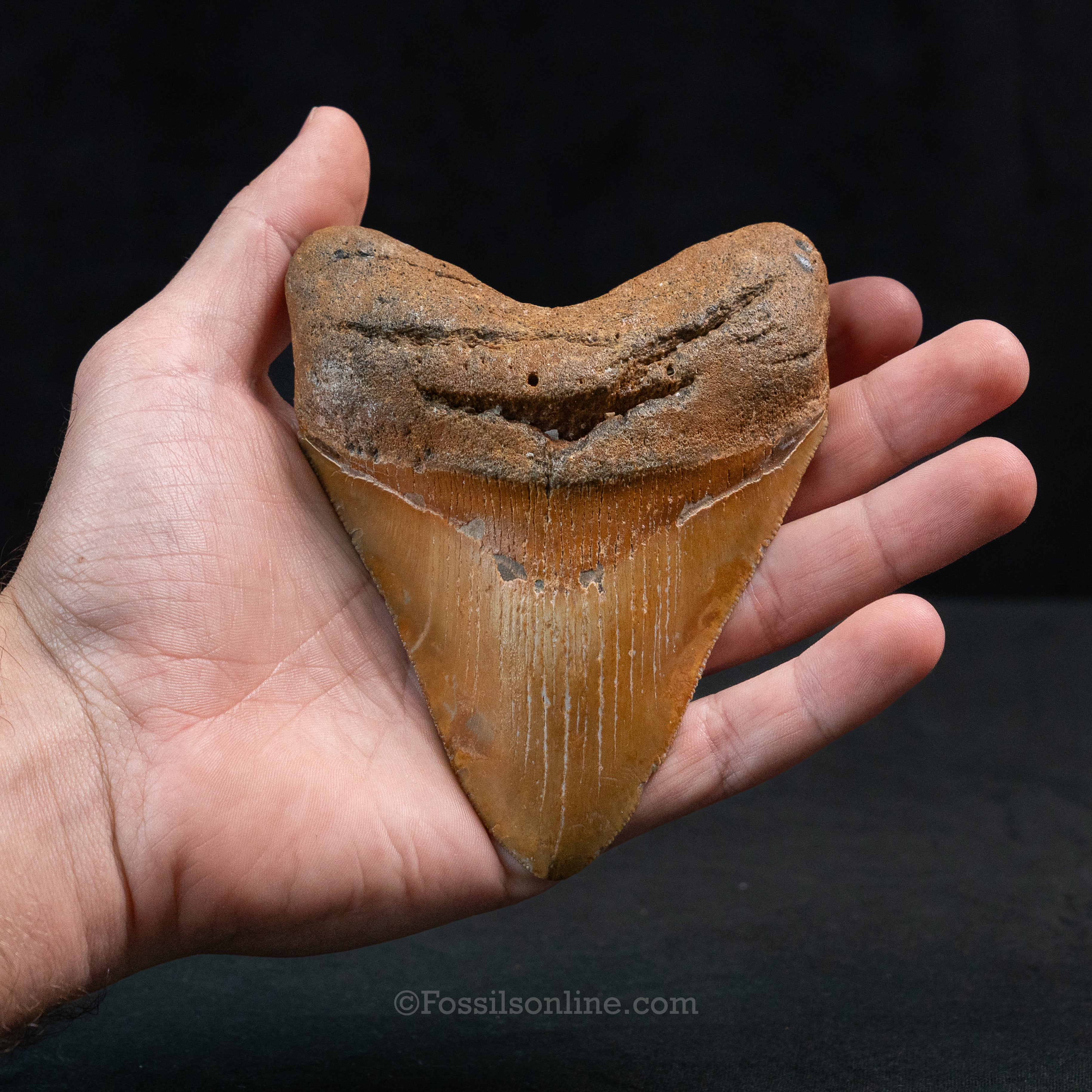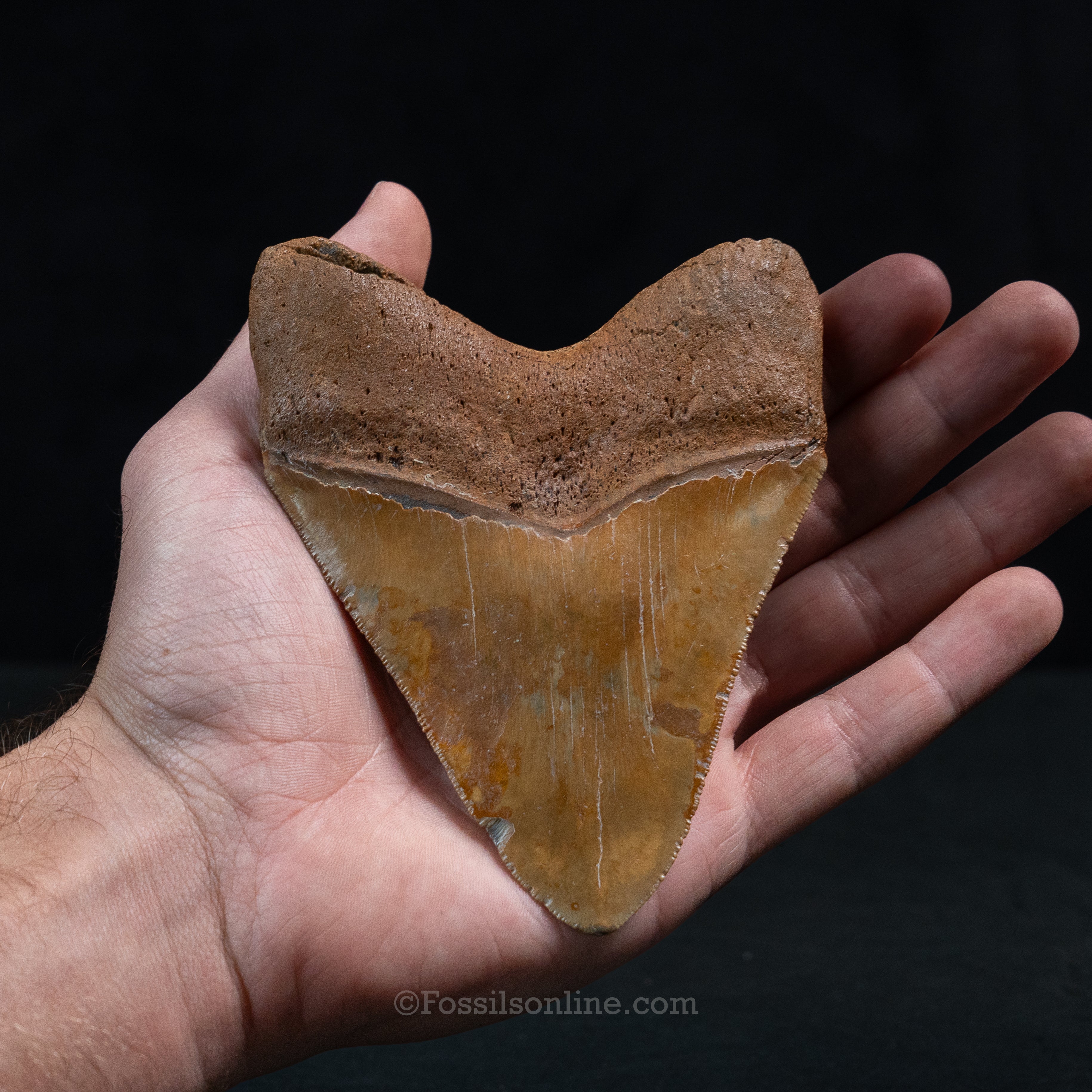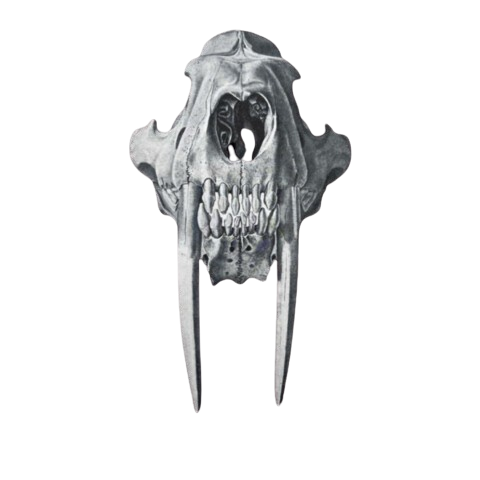

North Carolina Megalodon 4.78"
Large megalodon shark tooth from offshore North Carolina. beautiful orange coloration, a full bourlette and a nice thick symmetrical shape with visible serrations.
Why so many Megalodon teeth come from offshore North Carolina
The coast of North Carolina is one of the most famous Megalodon tooth localities in the world. Offshore of the modern beaches lies a broad continental shelf cut by ancient river channels and fossil-rich formations such as the Pungo River and Yorktown formations. These layers were laid down in shallow Miocene and Pliocene seas that were perfect habitat for Megalodon and the whales they fed on. As those sediments accumulated, teeth and other hard parts were buried and protected.
Today, strong currents, storms, and natural erosion slowly expose those fossil layers along “the ledges” and other drop-offs in 80–120 feet of water. Commercial fishing trawlers, dredging operations, and scuba divers working these ledges bring Megalodon teeth up from the seafloor. That’s why so many large, heavy, well-preserved Megalodon teeth on the market are labeled “offshore North Carolina.” The combination of the right age rocks, the shark’s former hunting grounds, and modern access by boats makes this area a steady producer of teeth year after year.
One of the big reasons Megalodon teeth are so popular with collectors is that they offer something almost no other “headline” fossil can: they’re both dramatic and surprisingly attainable. You get that museum-style wow factor without needing a museum-sized budget.
Affordability
When most people imagine fossils, they picture full dinosaur skeletons or famous Ice Age mammals—T. rex and Triceratops, sabertooth cats and Mammoths. Those fossils are rarer, difficult to collect, and expensive to prepare and display. Even small pieces of dinosaur bone or teeth from well-known species can be surprisingly costly for their size.
Megalodon teeth, on the other hand, give you huge visual impact for a fraction of the cost. They are instantly recognizable, even to someone who doesn’t know much about fossils. A large Meg tooth sitting on a shelf or desk has serious presence, and yet it is often far more affordable than comparably “famous” material from dinosaurs or Ice Age carnivores. For many collectors, a Megalodon tooth ends up being the most impressive fossil they can own without stepping into museum-level pricing.
Part of this comes down to how sharks live. Megalodon, like modern sharks, constantly shed and replace its teeth throughout its life. A single animal could produce thousands of teeth, and each one of those teeth had a chance to become a fossil. Compare this to ice age mammals that replaced their teeth far less. On top of that, Megalodon teeth are heavily mineralized and built to withstand crushing bites, so they fossilize and survive long-term far better than many delicate bones.
Their ancient habitat also helps. Megalodon lived in warm coastal seas around much of the world. Those marine sediments are now exposed in quarries, riverbanks, and offshore ledges that divers can actually reach. By contrast, the best dinosaur beds or Ice Age carnivore sites are often remote, heavily regulated, government land, or limited in how much material can be collected and sold. The result is that high-quality Megalodon teeth simply enter the collector market more frequently than complete ice age fossils or a nicely preserved dinosaur bone.
All of this puts Megalodon teeth in a sweet spot. They are genuinely rare natural objects, but common enough in the fossil record that collectors can still find good specimens. They belong to one of the most famous predators in Earth’s history, but they are still priced within reach of real-world budgets. For about what you might spend on a small dinosaur bone/ tooth or a single Ice Age bone you can often upgrade to a large, display-worthy Megalodon tooth with real size, weight, and presence.
That combination of fame, size, and attainability is why so many people choose a Megalodon tooth as the centerpiece of their collection. It’s a fossil that looks like it should be behind glass in a museum case—but instead, it can sit in your home or office as a very real, very tangible piece of the largest predatory shark that ever lived.
How Megalodon got so large
Megalodon’s gigantic size is the result of several evolutionary advantages coming together:
Warm-blooded-ish lifestyle (regional endothermy): Evidence from microscopic tooth and scale structures suggests that Megalodon could keep parts of its body warmer than the surrounding water, similar to some modern sharks (like great whites and makos). That warm, high-energy physiology helped it grow fast and power a huge body.
Plenty of big prey: During the Miocene and Pliocene, the oceans were full of whales and other marine mammals. A shark adapted to specialize on large, calorie-rich prey could afford to grow massive—each successful hunt provided a huge energy payoff.
Streamlined body built for cruising: Newer research suggests Megalodon may have had a more elongated, hydrodynamic body shape than the bulky versions often shown in older reconstructions. A sleeker design would reduce drag, making it easier for a huge shark to cruise long distances in search of food.
Why teeth are found, not skeletons
One of the most common questions is: “If Megalodon was so big, why don’t we find full skeletons?” The answer comes down to shark biology and fossilization:
Cartilage doesn’t fossilize well. Shark skeletons are made mostly of cartilage, not solid bone. After the shark dies, that cartilage decays and falls apart quickly, leaving little behind that can mineralize and survive millions of years.
Teeth are built to last. Megalodon teeth are thick, heavily mineralized, and coated in hard enamel. They handle crushing, biting, and even being rolled around on the seafloor far better than soft cartilage ever could.
Sharks constantly shed teeth. Like modern sharks, Megalodon replaced its teeth throughout its life. A single animal could shed thousands of teeth, each one a potential fossil waiting to be buried, preserved, and discovered later.
That’s why teeth are by far the most common Megalodon fossils. Occasionally, vertebrae and other fragments are found, but the teeth are what fill collections, museum exhibits, and jewelry cases around the world.
Megalodon’s disappearance
Megalodon ruled the oceans for roughly 15 million years before disappearing around 3.6 million years ago. Scientists are still debating why it went extinct, but leading ideas include:
Cooling oceans as the climate shifted, which may have reduced suitable warm-water habitat.
Changes in prey, as whale species evolved and some migration patterns shifted.
New competition from emerging predators like early great white sharks and toothed whales (orcas and their relatives), which may have hunted similar prey or even Megalodon juveniles.
Whatever the exact cause, by the time humans ever set foot in North America, Megalodon had been gone for millions of years—leaving its teeth as the main evidence it was ever here.
Color, preservation, and the “look” of North Carolina teeth
Collectors recognize North Carolina teeth at a glance. This is because they exhibit classic coastal colors – creams, tans, light browns, blue-gray or greenish enamel, and darker mineralized roots, caused by the phosphate-rich marine sediments of the Pungo River and Yorktown formations. They also have heavy, solid roots – the teeth often feel dense in the hand, with thick roots and broad crowns.
While many ledge teeth are worn smooth by sand and current, high-grade finds still show crisp, saw-like serrations and a clean cutting edge.
Because these teeth spent millions of years in moving seawater, every specimen carries its own wear pattern, color, and texture. No two are exactly alike.
LOCATION
Offshore North Carolina
Size
4.78"
Choose options


